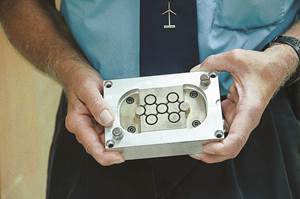Injection Molding Know-How: Drying Tips: A Dozen Details You Should Know
Drying is complicated.
Drying is complicated. There’s a lot more to it than just saying, “Dry polycarbonate at 250 F for 4 hr.” In our column last month, we discussed why you need to dry many resins in the first place (to control viscosity and maintain performance), the proper angle of the hopper bottom cone, which hoses to insulate, where and where not to vent the regeneration air, and the importance of monitoring temperature at the entrance and exit of the hopper. Yet there’s still a lot more to know about drying—enough to fill a book, at least.
As a bare minimum, here are a dozen details you need to know:
- Ever wonder why some dryers have an aftercooler in the return line to the cabinet? For the desiccant beds to work correctly, the air going into them needs to be below 150F. Therefore, if you are running the dryer hotter than 180F, you need to have an aftercooler on the return line (which should not be insulated) so the air is cooled for the desiccant. I believe the ideal temperature for the beds is about 130F.
- If you have some time and a bit of cash, rig up a thermocouple in the air feed just before the desiccant bed. Be careful not to interfere with the desiccant rotation mechanism. Put the readout on the control panel so you can monitor the air temperature going into the desiccant bed. If higher than 150F, you won’t get the best drying the desiccant can offer. This is better than guessing at the inlet air temperature.
- It will astound you to discover how many regeneration heater elements in your plant are not functioning correctly. If they are not working properly, you won’t regenerate (dry) the desiccant properly, and it won’t dry your resin as it’s intended to. A wise thing to do is put an “idiot light” on the control panel that tells you if the resistance of the elements in the regeneration heater is correct.
- Are your filters clean? You need to force a certain amount of air through the system—are you getting it? If you have lots of regrind or fines, check the filters every day.
- When was the last time you checked the desiccant? Is it still active? Read the supplier’s instructions and you may find a simple test of putting dry desiccant into a little bit of water and watching for a temperature rise. Desiccants can become contaminated or ruined by off-gases from processing certain resins. A general rule is to change the desiccant every 18 months. Desiccant isn’t cheap, but molded product recalls are much more expensive.
- Don’t forget the seals. Check for leaks and crushed hoses. Do it and do it right the first time.
- Ever get resin granules melting together in the hopper? You’ll wind up with a nice 200-lb pellet. Most of the time, that is not the fault of the material. It’s more likely the dryer bringing on stream the newly regenerated desiccant before it is cooled down properly. With some dryers, you can get a slug of 350F to 450 F air going into the drying hopper when the system switches desiccant beds.
- Dewpoint measurements help. Run at less than -25F dewpoint—better yet, a good dryer should run at -40F dewpoint. Measuring dewpoint of the drying air does not tell you if the resin is dry, it just tells you whether the dryer has the ability to dry the resin.
- Testing some dried resin for moisture content is the only sure way to know if you are drying correctly. There are a number of ways to measure moisture. Make sure your method is measuring just moisture—not all volatiles driven off a sample of pellets.
- Once dry, most resins will pick up moisture in 15 to 30 min. Therefore, do not convey from a central hopper to the machine, or leave it in the machine’s hopper, without a blanket of dry air.
- Note where the dry air enters the hopper and meets the resin. Hot air will only travel upward. Do not believe the arrows on dryer drawings. Air takes the path of least resistance. The bottom of the hopper is usually blocked. Therefore, any resin below the dry-air distribution hardware (look for a dip tube) must be drained and put back on top of the hopper load before you start molding. You do not want to process that bottom 20 to 75 lb, as it is wet and you’ll ruin it.
- If you dry cellulosics, TPUs, flexible PVC, TPVs, and some other soft-touch resins, check the desiccant’s condition every six months, because these materials emit volatiles that can ruin desiccant.
About the Author
John Bozzelli is the founder of Injection Molding Solutions (Scientific Molding) in Midland, Mich., a provider of training and consulting services to injection molders, including LIMS and other specialties. E-mail john@scientificmolding.com or visit scientificmolding.com.
Related Content
How to Select the Right Tool Steel for Mold Cavities
With cavity steel or alloy selection there are many variables that can dictate the best option.
Read MoreWhat to Look for in High-Speed Automation for Pipette Production
Automation is a must-have for molders of pipettes. Make sure your supplier provides assurances of throughput and output, manpower utilization, floor space consumption and payback period.
Read MoreProcess Monitoring or Production Monitoring—Why Not Both?
Molders looking to both monitor an injection molding process effectively and manage production can definitely do both with tools available today, but the question is how best to tackle these twin challenges.
Read MoreA Systematic Approach to Process Development
The path to a no-baby-sitting injection molding process is paved with data and can be found by following certain steps.
Read MoreRead Next
See Recyclers Close the Loop on Trade Show Production Scrap at NPE2024
A collaboration between show organizer PLASTICS, recycler CPR and size reduction experts WEIMA and Conair recovered and recycled all production scrap at NPE2024.
Read MoreFor PLASTICS' CEO Seaholm, NPE to Shine Light on Sustainability Successes
With advocacy, communication and sustainability as three main pillars, Seaholm leads a trade association to NPE that ‘is more active today than we have ever been.’
Read More
.jpg;width=70;height=70;mode=crop)
















